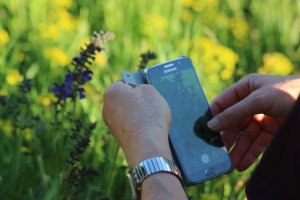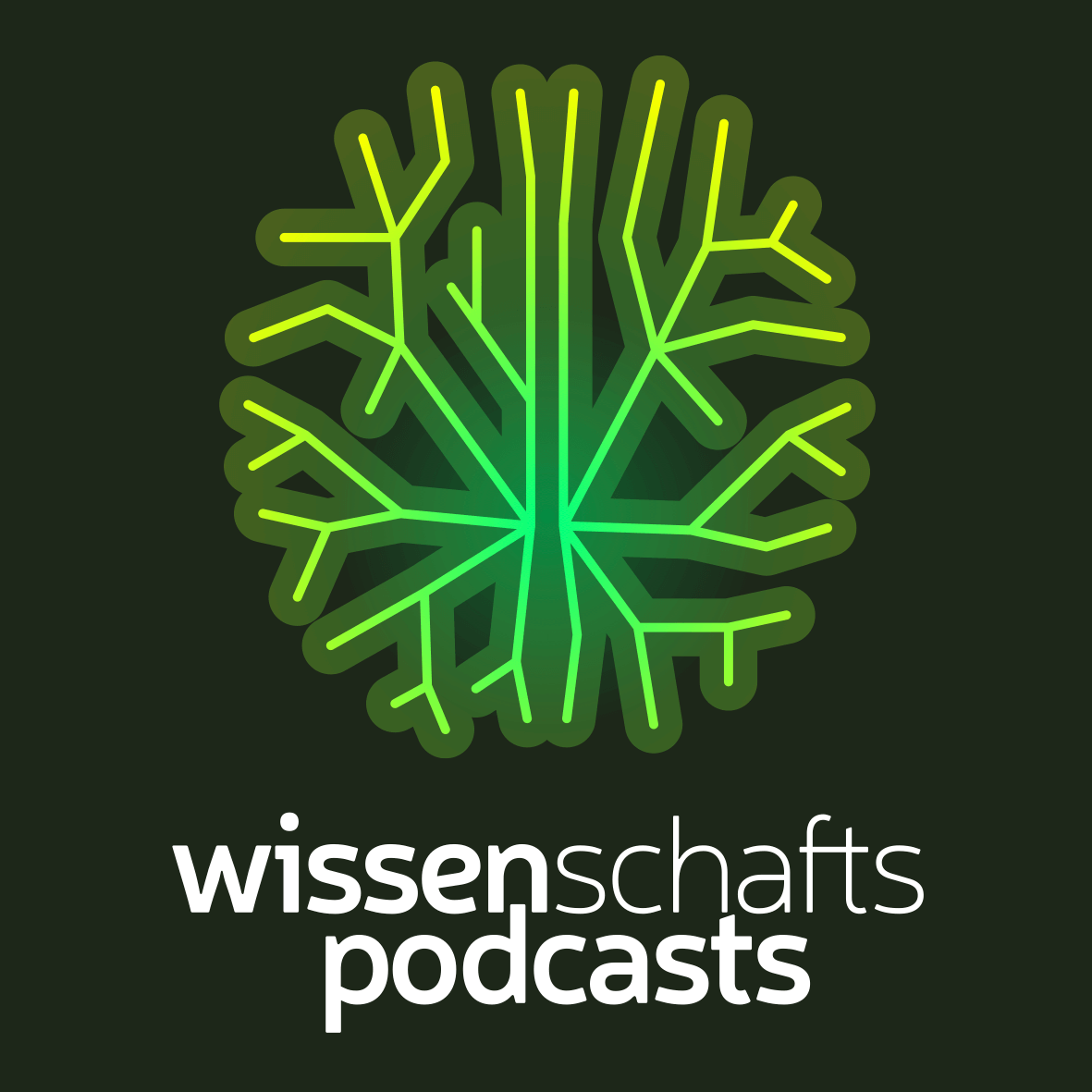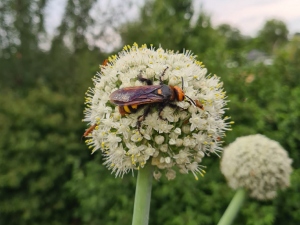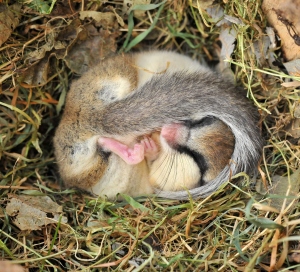
Florian Heigl
Camaliot
The CAMALIOT (Application of Machine Learning Technology for GNSS IoT Data Fusion) project
The CAMALIOT project integrates data from the Internet of Things (IoT), including smartphones, and traditional Global Navigation Satellite System (GNSS) data sources to leverage Big Data, Data Fusion and Machine Learning technologies to to demonstrate how these data can be used in different scientific applications.
Taking advantage of dual frequency chipsets now available in some Android mobile phones, the CAMALIOT Android app logs data from all available satellites. The purpose of the mobile app is to collect as much raw GNSS data as possible from as many locations around the world using crowdsourcing. The data are being ingested into machine learning algorithms for determination of tropospheric parameters that support weather forecasts on Earth and for the monitoring of space weather, important for satellite operations and communication. More information about the scientific results can be found on the www.camaliot.org website. A paper describing the app and the data collection campaigns can be found here in the International Journal of Digital Earth.
Although the CAMALIOT project funding is now finished, we are still collecting data through the CAMALIOT mobile app for the acquisition of raw, crowdsourced GNSS data to support ongoing scientific research.
The project has three main partners: (i) the European Space Agency, who funded the project and provided scientific support; (ii) ETH Zurich, who led the project and have developed the machine learning models for weather prediction; and (iii) the International Institute for Applied Systems Analysis (IIASA), who developed the CAMALIOT crowdsourcing app and have led the data collection as outlined on the project's website.
This project fulfils version 1.1 of the quality criteria for citizen science projects on Österreich forscht.
Podcast Episode 2
Listen to the new podcast episode now: https://www.citizen-science.at/blog/radio-von-gottesanbeterin-baumschlaefer-und-fruehjahrsbluehern
Team
We at Österreich forscht value good cooperation and enjoy working as a team, as we complement each other well. Here, all our staff members introduce themselves, their interests and hobbies, and describe what they particularly appreciate about Citizen Science and their work at Österreich forscht. We hope you enjoy getting to know our team members.
Daniel Dörler
Founder and coordinator of Österreich forscht

Daniel is a zoologist and already planned to study zoology as a child. He realised his career aspiration and graduated from the University of Vienna in zoology with a focus on evolutionary biology. After a short break in the private sector, he completed his doctorate in ecology at BOKU University, where he first came into contact with Citizen Science.
At Österreich forscht, he is responsible for updating platform content, (re)designing texts and platform areas, and posts regularly on Facebook. Daniel writes on the blog and organises and coordinates the events of Österreich forscht. He also gives lectures and presentations on citizen science, conducts courses and training sessions on citizen science and is also very well networked internationally in the field of citizen science through his role as head of a European working group on Citizen Science Networks.
What excites me about citizen science .... the opportunity of working together with a group of committed people to discover things that could not be discovered without citizen science. For me, citizen science is a group experience that is fun, sometimes challenging and opens up new perspectives.
What I like about my work is ... the variety. In my role as coordinator of Österreich forscht and researcher at BOKU, I am always at the interface between science and society, and I also have insights into many different research areas and organisations, which allows me to constantly gain new experiences.
I recharge my batteries ... on the one hand through direct (and hopefully positive) feedback during presentations and lectures, and on the other hand through regular time off.
The best balance to work for me is ... sports, quality time with friends and travelling.
I find inspiration ... mostly while running, when I let my thoughts run freely and don't think about anything in particular.
Florian Heigl
Founder and coordinator of Österreich forscht

Florian is an agroecologist, specialising in road ecology and citizen science during his PhD at BOKU University. During his doctorate, he founded the platform Österreich forscht together with Daniel and has been developing it ever since.
At Österreich forscht, Florian is primarily responsible for strategic development and coordination. He takes care of platform content, writes on the blog and manages the Österreich forscht LinkedIn account. He also conducts research in the Roadkill project, teaches several courses and training sessions on citizen science at BOKU and leads working groups in the Citizen Science Network Austria.
When Florian is not working on citizen science, he can be found in the Waldviertel with his family, either playing with his children, in the garden or on the water with his kayak.
What excites me about citizen science is ... the combination of scientific theory and practice as well as the exchange with wider society. Through this exchange, I hope that we can solve problems in our environment together and with scientific methods.
What I like about my work is ... the diverse fields of activity and the constant change of perspectives.
I recharge my batteries ... in the garden or on the water.
The best balance to work for me is ... playing with the children and doing sports in nature.
I find inspiration ... in nature.
Barbara Heinisch
Project assistant
 Barbara does her research and teachings in the field of specialised translation and also works as a translator and terminologist at the University of Vienna. She is enthusiastic about Citizen Science from different perspectives (both in theory and practice as well as on a strategic level). During her doctorate, she already gained her first experience with citizen science as a project coordinator and dealt extensively with the "translation" aspect of science, which also led her to BOKU University.
Barbara does her research and teachings in the field of specialised translation and also works as a translator and terminologist at the University of Vienna. She is enthusiastic about Citizen Science from different perspectives (both in theory and practice as well as on a strategic level). During her doctorate, she already gained her first experience with citizen science as a project coordinator and dealt extensively with the "translation" aspect of science, which also led her to BOKU University.
At Österreich forscht, she is implementing the Citizen Science strategy of Österreich forscht together with Daniel and Florian. To this end, she will work with the partners to implement activities that increase cooperation between projects and the visibility of Österreich forscht.
What excites me about Citizen Science is ... developing science further, being able to provide an insight into research and, ideally, using research to achieve an impact outside of science.
What I like about my work is ... not just looking at Citizen Science in Austria from the perspective of theory and practice, but being able to develop and drive it forward myself.
I recharge my batteries ... in the countryside.
The best balance to work for me is ... not thinking about work ?.
I find inspiration ... through new and unknown things, as well as different perspectives.
Meret Siemen
Student Assistant
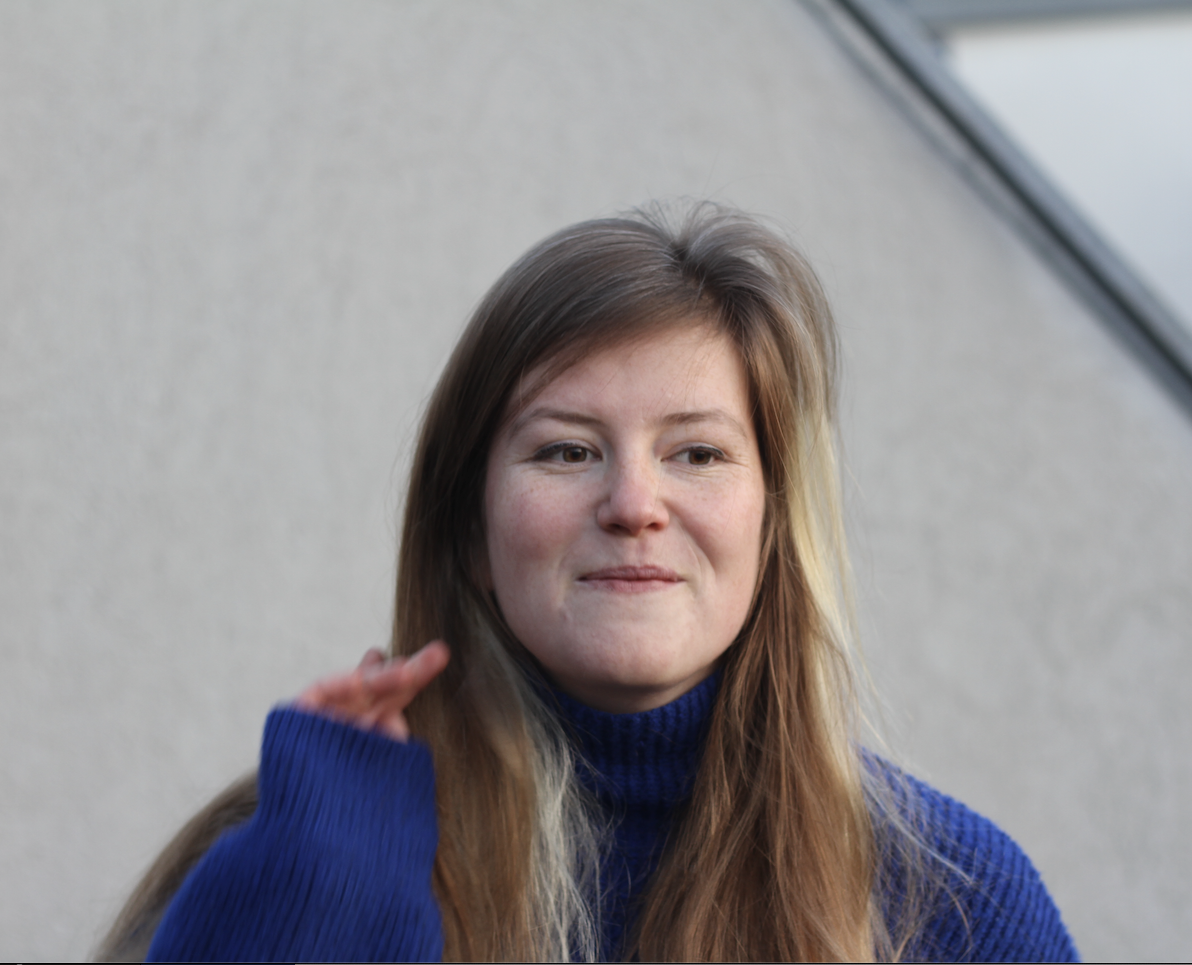 Meret Siemen is pursuing a Master's degree in Philosophy and feels very comfortable at BOKU despite her love for the humanities. After some forays into the art and cultural sector, working in theater, and spending several years at the Chair of Philosophy and Ethics in School and Society at the University of Vienna, she has finally extended her feelers towards science journalism. With years of experience in community radio, she can now combine her passion for asking questions and learning with journalistic practice.
Meret Siemen is pursuing a Master's degree in Philosophy and feels very comfortable at BOKU despite her love for the humanities. After some forays into the art and cultural sector, working in theater, and spending several years at the Chair of Philosophy and Ethics in School and Society at the University of Vienna, she has finally extended her feelers towards science journalism. With years of experience in community radio, she can now combine her passion for asking questions and learning with journalistic practice.
At Österreich forscht, she is responsible for producing the Citizen Science podcast "Wissen macht Leute," which she took over from Alina Hauke in early 2025. She ensures that all content on the website is up to date and meets the criteria for accessibility and gender-inclusive language. Additionally, she supports Florian and Daniel with other administrative tasks, social media, and the blog.
What excites me about Citizen Science ... is the respectful (and often enthusiastic!) engagement and relationship between academics and non-academics. The mutual learning process, which, in addition to scientific results, also brings joy.
What I like about my work is ... observing how much joy science can bring to people. Also: The friendly interaction, curiosity and openness, and that I'm allowed to ask anything.
I recharge my energy ... by swimming, making collages, or creating music.
The best balance to work for me is ... meeting friends, listening to the radio, reading, cooking, and going on vacation.
I find inspiration ... actually everywhere. Just open your eyes and prick up your ears.
Alina Hauke
Project assistant

For Österreich forscht, Alina established the Citizen Science podcast "Wissen macht Leute" with support from Lisa Recnik and produced it until the end of 2024. Since the beginning of 2025, Alina has been organizing the "Leading Lights" project, which supports and promotes early-career scientists at BOKU University in science communication.
What excites me about Citizen Science ... is the involvement of many different people, the open and inclusive approach, as well as the effort to make science more tangible.
What I like about my work is ... coordinating, my independence, and my creative freedom.
I recharge my energy ... through exchanges with dear people, in nature, and through sports.
The best balance to work for me is ... going outside, climbing, reading, and realizing creative projects.
I find inspiration ... while traveling, listening to music, and taking walks.
City Nature Challenges in Austria
Every observation counts!
The City Nature Challenge (short: CNC) is an annual nature competition between regions that takes place in spring (usually at the end of April, beginning of May) and is held simultaneously in various cities and regions worldwide. On four consecutive days, people around the world document the diversity of wild animal, plant and fungi species in their region using photos and sound recordings and share them on iNaturalist. Together with others the observations are then identified to species level on iNaturalist.
The CNC was invented by the Natural History Museum of Los Angeles County and the California Academy of Sciences in 2016 and is organized by them since then annually. 2018 the CNC went globally, and hundreds of cities and regions are participating since then in this friendly challenge every year: Which region makes the most observations? Which region has the most species? Which region can motivate the most participants?
All observation of wild organisms in the participating regions count!
Since 2020, several Austrian cities and region are also participating in this international event. The CNC is organized by each of the participating cities or regions on their own. The “City Nature Challenges in Austria” project acts as an umbrella project for these participating cities and regions in Austria.
The aim of the CNC is to reacquaint people with their local biodiversity, to arouse curiosity and to discover nature on their doorstep. You can use the observation platform iNaturalist to exchange ideas with other nature lovers and learn and improve your knowledge of the species by identifying species together with others. This data helps research, administration, and nature conservation: it contributes to a better understanding of the status of species and their distribution in Austria. Due to the large number of observations, robust data on phenology can be obtained, area expansions of invasive species or of rare/sensitive species can be detected, and rediscoveries and new finds are also possible.
When?
The next City Nature Challenge takes place from April 25th to 28th 2025. Planning for the 2026 CNC event already starts in autumn 2025.
Participate
Everyone can participate in the City Nature Challenge by making observations or help identifying observations to species level! No registration to the project is necessary. All you need is a camera (smartphone or digicam) and a free iNaturalist account for uploading the photos. In Salzburg and Vorarlberg, Observation.org and the ObsIdentify app are used to collect data. The use of both platforms is free of charge.
Now, simply take photos of wild animal, plant or fungi species between April 25th and 28th 2025 in the participating regions and post them on iNaturalist. That is all it takes for your observation to count in the City Nature Challenge!
You can also help identify species on iNaturalist submitted during the CNC. Or simply tell your family, friends or colleagues that the CNC is happening in their region.
iNaturalist is a citizen science platform where everyone can post images or sound recordings of their species observations and identify it together with other users. It is run by the California Academy of Sciences and the National Geographic Society. Beside the documentation of biodiversity users can also get in exchange with each other over the platform.
In Austria, you can take part in the City Nature Challenge in 2025 in the following regions:
- Amstetten – Waidhofen/Ybbs
- Elsbeere Wienerwald
- Graz bis Vulkanland
- Industrieviertel
- Innsbruck
- Krems – Wachau – Melk
- Marchegg
- Mittelkärnten
- Nationalparkregion Gesäuse
- Neusiedler See/Seewinkel
- Salzburg (via observation.org)
- St. Pölten
- Vorarlberg (via observation.org)
- Wien
What’s with the data?
The observations reported to iNaturalist during the course of the CNC can be viewed and used by any user of the observation platform. So they are freely available. In addition, verified observations (which have the status of "research grade") are shared with GBIF "Global Biodiversity Information Facility" – an international biodiversity database – used by scientists worldwide for their research. In addition, the observations are also available in the Austrian Biodiversity Atlas with a slight delay.
Through your iNaturalist account, you can control how your observations and photos may be used (by providing a Creative Commons license) and you can also remove your observations at any time by deleting your account.
Podcast episode
In April 2023, coordinator of the region Krems-Wachau-Melk, Tanja Lumetsberger, presented futher insights and details about the City Nature Challenge in our podcast Wissen macht Leute. You can listen to the episode here (in German).
Further information
Further information on the City Nature Challenges in Austria and how you can be part of it can be found on our project website.
Information on the official international project can be found at www.citynaturechallenge.org (in English).
Implementing organisations
- Haus der Natur Salzburg
- Haus für Natur, Museum Niederösterreich
- inatura Vorarlberg
- Institut für Biologie, Universität Graz
- Nationalpark Gesäuse
- Nationalpark Neusiedler See – Seewinkel
- Naturhistorisches Museum Wien
- Naturwissenschaftlicher Verein für Kärnten
- Paris-Lodron Universität Salzburg
- Tiroler Landesmuseen
- Universalmuseum Joanneum
- Universität für Weiterbildung Krems
The City Nature Challenge is organized on a global scale by the Natural History Museum of Los Angeles County and the California Academy of Sciences.
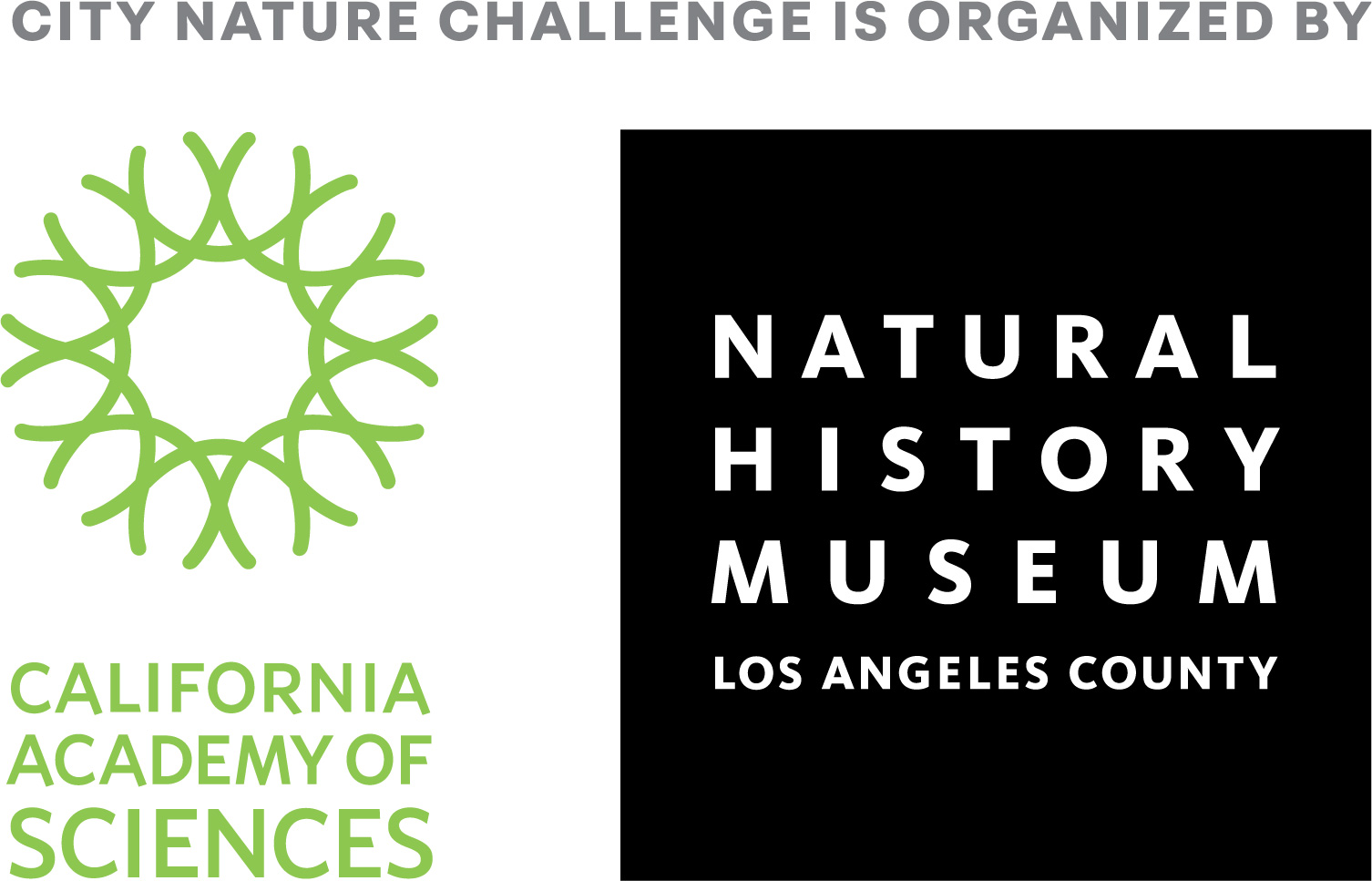
This project fulfils version 1.1 of the quality criteria for citizen science projects on Österreich forscht.
Memories and Imaginaries
Democratic Citizenship
"Memories and Imaginaries" critically explores with students in Austria what it means to be a citizen. Who can or is allowed to actively participate in the political community? Who can or is not allowed to? We address these questions with the aim of finding collective strategies to confront the state of exclusion and marginalization.
The aim of the research is for researchers to explore the importance of remembering, retelling and re-imagining the past and the future plays in living and participating in a political community.
In every community there are different stories of belonging and exclusion. The particular focus will be on migrant, queer and Jewish memories and imaginaries. In their own ways, they all represent stories of exclusion from Austrian society.
We explore how democratic citizenship works by practicing it on a small scale: Students, artists and researchers come together to learn, share and listen about migrant, queer and Jewish memories and ideas. The Citizen Scientists themselves may also bring and share their own experiences of exclusion.
The project sets new impulses in the field of Citizen Science, as it combines Citizen Science with art-based research. Memories and imaginaries are collective and relational forms of knowledge that are experiential, multi-layered in space and time. Citizen science and art-based research are innovative ways to gain insights into such imaginaries and their potential for democratic citizenship.

© Felix Deiters
How to participate?
During the co-research period from May to June 2022, a total of three "Remembrance Labs" (May) and one General Assembly (June) took place. The citizen scientists each took part in one of the three labs, which had the same content.
The interim results of all three labs, in the form of graphic recordings and stenographic minutes, were reflected on together in a joint general assembly at the end of June and the collected output was jointly verified.
The Labs artistically took us through the past and present of the three selected communities and enabled collective reflection on how we share situations of exclusion and how we can imagine them if we have not experienced them ourselves or if we do not remember them ourselves (for example because we are too young).
Eating together was as much a part of the collective experience as the mental and physical-affective participation in three group-dynamic, artistically guided exercises.
Artistic inputs were given in each memory lab, in which the Citizen Scientists were also invited to actively participate:
- Rap-poetry with Esra Özmen aka EsRap on the topic of migration,
- Building community by performative story-telling with artist Ndidi Iroh,
- Researching biographies: multi-marginalisations from a jewish perspective.
An expert was invited to each Remembrance Lab to present a short input for the discussion. They came from important civil society organisations:
- Dokumentationsarchiv des österreichischen Widerstandes (DÖW),
- Wiener Wiesenthal-Institut für Holocaust-Studien,
- PH Upper Austria.
The results of the research phase are currently being evaluated and will be published in the form of an artistic book in 2023.
What happens to the contributions of the Citizen Scientists?
The activities during the labs will be documented visually and textually by means of graphic recording (artist Felix Deiters) and a stenographic protocol.
The graphic and stenographic protocols will be included in the book publication "Memories and Imaginaries: Democratic Citizenship". The book will be produced in the last phase of the project (autumn 2022) and presented at a closing event in January 2023.
Contact and research team of the Academy of Fine Arts Vienna
Univ.-Prof. Dr. Marina Gržinić: This email address is being protected from spambots. You need JavaScript enabled to view it.
Dr. Sophie Uitz: This email address is being protected from spambots. You need JavaScript enabled to view it.
Dr. Jovita Pristovšek: This email address is being protected from spambots. You need JavaScript enabled to view it.
This project fulfilled version 1.1 of the quality criteria for citizen science projects on Österreich forscht.
Zeit.shift
Offers active beyond the duration of Zeit.shift
The Zeit.shift project ended in June 2023. The central web offerings continue to be active beyond the project duration. Specifically, the results can be followed via the website. The newly generated web portal is accessible worldwide and the text material provided (several million newspaper pages) is searchable and downloadable. Geodata and content tags can be assigned via an external platform and the online game Ötzit! is freely available. However, an evaluation of the generated data, as formulated in the project description, no longer takes place after the end of the project.
What is the Zeit.shift project about?
The aim of the Zeit.shift project is to establish a long-term, cross-border cooperation for the preservation, development and dissemination of the cultural text heritage of Tyrol and South Tyrol from the late 19th and early 20th centuries. Using historical newspapers as a prototype, the text collections are to be preserved in the long term and made accessible to the general public in a web portal. This offers the opportunity to learn more about one's own cultural heritage and to learn to appreciate historical texts as a source for exciting discoveries. An important focus of the project is the active involvement of the population. Interested citizens are invited to participate and can contribute to the text indexing by annotating the text material online. Together with citizens, relevant key terms and the correct location of the text excerpts will be added in order to improve the usability and searchability of the historical text material.
How can one participate?
Via the Historypin platform, interested citizens can participate in text indexing by describing the content of advertisements in historical daily newspapers and geolocating them via Google Maps in order to virtually reconstruct the shopping streets of 100 years ago. In this way, one can gain an insight into which products were traded and which events took place in yesterday’s world. One discovers professions and trades, some of which no longer exist, and has the opportunity to draw one's own comparisons of what can be found in the places mentioned today. This is only a small excerpt of the variety of topics offered by the advertisements in the press of that time - a voyage of discovery into the world of our ancestors. Participation is not tied to a specific time or place; all you need is internet access and a computer or smartphone. Tutorials will help with questions, and there is also the possibility of contacting the Zeit.shift project staff directly (This email address is being protected from spambots. You need JavaScript enabled to view it.). The citizen science activities are aimed at all citizens and no special knowledge is necessary to participate in the project.
Another citizen science approach in the Zeit.shift project was developed with the gamification application Ötzit!. The online game Ötzit! is about saving Ötzi from dangerous animals by correctly typing out falling words in Fraktur script. A game against time! Ötzit! is primarily aimed at German-speaking pupils aged 11-14, but is open to anyone interested. The aim of the game is to create an awareness of the digitised newspaper collections and to practise reading historical documents in Fraktur script. All data anonymously provided by the players (e.g. typed words) was analysed and used to explore automated OCR corrections via crowdsourcing and to improve the searchability of the digitised collections.
Why is it important and what happens to the data?
The benefit for the citizens is to experience the newspapers as a historical source and to learn something about their own cultural heritage through them. Together with the project team, they discover hidden archival treasures, thus making an invaluable contribution to indexing. In the project, the Zeit.shift portal for archiving, managing, researching and presenting digitised historical daily newspapers of the Tyrolean region was implemented. Using search filters, such as place and family names, time period, etc., the search results can be narrowed down precisely and the search term appears in the full text highlighted in colour. The data generated by the Citizen Science activities serve as support for the computer-linguistic analysis (e.g. correction of recognition errors in digitised texts in Fraktur script).
Photo gallery
-
 Unterinntaler Bote, 03.01.1908, S. 6 Unterinntaler Bote, 03.01.1908, S. 6
Unterinntaler Bote, 03.01.1908, S. 6 Unterinntaler Bote, 03.01.1908, S. 6 -
 Schwazer Lokal-Anzeiger, 16.04.1927, S. 4 Schwazer Lokal-Anzeiger, 16.04.1927, S. 4
Schwazer Lokal-Anzeiger, 16.04.1927, S. 4 Schwazer Lokal-Anzeiger, 16.04.1927, S. 4 -
 Unterinntaler Bote, 03.01.1908, S. 6 Unterinntaler Bote, 03.01.1908, S. 6
Unterinntaler Bote, 03.01.1908, S. 6 Unterinntaler Bote, 03.01.1908, S. 6 -
 Reuttener Nachrichten, 04.07.1930, S. 3 Reuttener Nachrichten, 04.07.1930, S. 3
Reuttener Nachrichten, 04.07.1930, S. 3 Reuttener Nachrichten, 04.07.1930, S. 3 -
 Unterinntaler Bote, 03.01.1908, S. 8 Unterinntaler Bote, 03.01.1908, S. 8
Unterinntaler Bote, 03.01.1908, S. 8 Unterinntaler Bote, 03.01.1908, S. 8 -
 Unterinntaler Bote, 03.01.1908, S. 10 Unterinntaler Bote, 03.01.1908, S. 10
Unterinntaler Bote, 03.01.1908, S. 10 Unterinntaler Bote, 03.01.1908, S. 10 -
 Unterinntaler Bote, 03.01.1908, S. 7 Unterinntaler Bote, 03.01.1908, S. 7
Unterinntaler Bote, 03.01.1908, S. 7 Unterinntaler Bote, 03.01.1908, S. 7 -
 Reuttener Nachrichten, 27.06.1930, S. 4 Reuttener Nachrichten, 27.06.1930, S. 4
Reuttener Nachrichten, 27.06.1930, S. 4 Reuttener Nachrichten, 27.06.1930, S. 4 -
 Schwazer Lokal-Anzeiger, 16.04.1927, S. 4 Schwazer Lokal-Anzeiger, 16.04.1927, S. 4
Schwazer Lokal-Anzeiger, 16.04.1927, S. 4 Schwazer Lokal-Anzeiger, 16.04.1927, S. 4 -
 Reuttener Nachrichten, 01.02.1929, S. 4 Reuttener Nachrichten, 01.02.1929, S. 4
Reuttener Nachrichten, 01.02.1929, S. 4 Reuttener Nachrichten, 01.02.1929, S. 4
https://www.citizen-science.at/en/component/k2/author/934-florianheigl?start=90#sigProId4ff201727f
Video

This project fulfilled version 1.1 of the quality criteria for citizen science projects on Österreich forscht.
Podcast
“Wissen macht Leute” - the Citizen Science Podcast by Österreich forscht
Since March 2022, Österreich forscht has been producing a monthly radio programme for Radio Orange that revolves around the topic of Citizen Science: "Wissen macht Leute" (knowledge makes people). Each episode brings listeners closer to the topic through interviews with scientists, citizen scientists or decision-makers. Projects coming from a broad range of scientific disciplines and their relation to our society are discussed – this way, we want to reflect the diversity of projects and activities in the field of Citizen Science in the German-speaking countries. Through personal stories, we explore the path of scientists and citizen scientists into research in order to make science more tangible.
With "Wissen macht Leute" we want to make the topic of Citizen Science better known and attract the listeners’ interest in it. We want to present the diversity of Citizen Science and invite interested citizens to participate in the scientific projects listed on our platform. "Wissen macht Leute" thus wants to build a bridge between science and society and encourage listeners to get involved in research processes.
The podcast is broadcast on Radio Orange every 3rd Monday of the month from 2 to 2:30 pm and can also be streamed afterwards at our Blog, the Cultural Broadcasting Archive, on Spotify or on Apple Podcasts. If you prefer to use another platform, you can also subscribe to our RSS feed.
We're also happy to announce that you can also listen zu "Wissen macht Leute" in other free radio stations in Austria:
- on Radio Proton (Vorarlberg) every 3rd or 4th Wednesday Mittwoch of the month from 12:30 to 1 p.m.,
- on Radio Freirad (Innsbruck/Tyrol) every 3rd Friday of the month from 4:06 to 4:37 p.m.,
- in the Radiofabrik (Salzburg) every 4th Tuesday of the month at 6:30 p.m.,
- on Radio B138 (Upper Austria) every 4th Monday of the month at 1:15 p.m.,
- on Radio Fro (Linz, Upper Austria) every even Monday from 5 to 5:30 p.m.,
- and on the Campus & City Radio St. Pölten 94.4 every 3rd Monday of the month from 5:30 to 6 p.m.
Episodes (in German)
- 1st episode: Forschen Sie mit!
- 2nd episode: Von Gottesanbeterin, Baumschläfer und Frühjahrsblühern
- 3rd episode: Die inatura Erlebnis Naturschau und Citize Science
- 4th episode: Heute kann es regnen, stürmen oder schneien (Wettermelden.at)
- 5th episode: Austrian Citizen Science Conference 2022 (report)
- 6th episode: Wanted: Die Asiatische Mörtelbiene (BeeRadar)
- 7th episode: Citizen Science in urban development (Werkstatt Neu Leopoldau)
- 8th episode: Citizen Science in conservation areas
- 9th episode: Was flattert denn hier? (Schmetterlinge Österreichs)
- 10th episode: Welche Vögel sind jetzt da? (Stunde der Wintervögel)
- 11th episode: Prähistorische Webtechniken und Citizen Science (weaving techniques)
- 12th episode: Tiere unter Rädern (project Roadkill)
- 13th episode: Citzen Scientists am Wort (birthday special)
- 14th episode: Ein Wochenende für die Artenvielfalt - die City Nature Challenge
- 15th episode: In Linz beginnt's (Austrian Citizen Science Conference 2023)
- 16th episode: Brandaktuell - die Fire-Database
- 17th episode: Geschichte schreiben - Briefe aus der Wienbibliothek
- 18th episode: Die Zukunft der Wissenschaft - über die Partizipationsinitiative "IdeenLauf"
- 19th episode: Die Pilze sind los! (Pilzfinder & Pilzdaten Austria)
- 20th episode: Moral im Alltag (Everyday Morality)
- 21st episode: Citizen Science in Europe
- 22nd episode: My Tune - Citizen Science in Music Therapy
- 23rd episode: Fossilfinder - Citizen Science in the Earth Sciences
- 24th episode: On the trail of amphibians and reptiles (AmphiBiom & Herpetofauna)
- 25th episode: HPV: Humane PapilloWAS?
- 26th episode: The Citizen Science Award 2024 - behind the scenes
- 27th episode: The Austrian/European Citizen Science Conference 2024
- 28th episode: Citizen Science at BOKU University
- 29th episode: Mosquito-Alert!
- 30th episode: The history of Citizen Science in Austria
- 31st episode: Following footsteps of the Plastic Pirates
- 32nd episode: Citizen Science at the international book fair Buch Wien 2024
- 33rd episode: Gaming 4 Science: Open Reassembly
- 34th episode: ABC of Dialects
- 35th episode: The Psychological is participatory - What does it take for a good life?
- 36th episode: Naturkalender - The social network for nature observations
- 37th episode: Catching (bird) voices with Breeding bird monitoring
"Wissen macht Leute" is also listed on Wissenschaftspodcasts, a platform for podcasts about science and knowledge.
Mammoth wasp
The mammoth wasp Megascolia maculate is the largest wasp species in Europe with a body length of up to 4.5 cm. In Austria, a few specimens of the mediterranean species were found in Vienna and Lower Austria at the end of the 19th century. Since then, there have been sporadic sightings in eastern Austria in recent years. Due to the current climatic warming it can be assumed that the species will spread further in Austria in the next years. In order to observe and document this, we need your help.
As the species is still very rare in Austria and the flight time is very short, it is almost impossible to find it by active search, let alone to get an overview of the current occurrences in Austria. However, if many people keep their eyes open and observe the activity in their surroundings, success is certain, because the wasp is hard to miss!
The wasps hatch in our latitudes in June and can be observed until about mid-July. The adults feed on nectar and visit preferably blue and reddish-blue flowers from various families, such as the genus Allium, Eryngium or thistles, when foraging; they have also been observed on the common silk plant. The males, which usually hatch a week earlier, fly in search of females at a height of 50 to 150cm. The females mate fairly soon after their appearance and then search for a suitable host for oviposition: grubs of rhinoceros beetles, stag beetles, or walkers are accepted. The larvae of the mammoth wasp grow throughout the summer and then overwinter as a pupa in a cocoon, from which an adult wasp hatches again in the following early summer.
Observations are mostly made while nectar-feeding on flowers. In Austria, the species has so far been observed on the common milkweed, hollyhock, lavender and leek. Since the beginning of the citizen science project, the red-fronted dagger wasp has already been documented at 12 sites in northeastern Austria. The westernmost sites so far are Mistelbach and Strasshof an der March.
Recognition of the mammoth wasp
Besides its considerable size of up to 4.5cm body length, the most striking features of the mainly black and bristly-haired wasp are the yellow, orange-red or red colored head with large mandibles and the yellow spots on the abdomen. The posterior part of the abdomen is covered with reddish bristles.
Attention! There is a risk of confusion with another, smaller species, which is commonly found in our area: The hairy flower wasp (Scolia hirta) has yellow spots on the abdomen as well, but a black colored head!
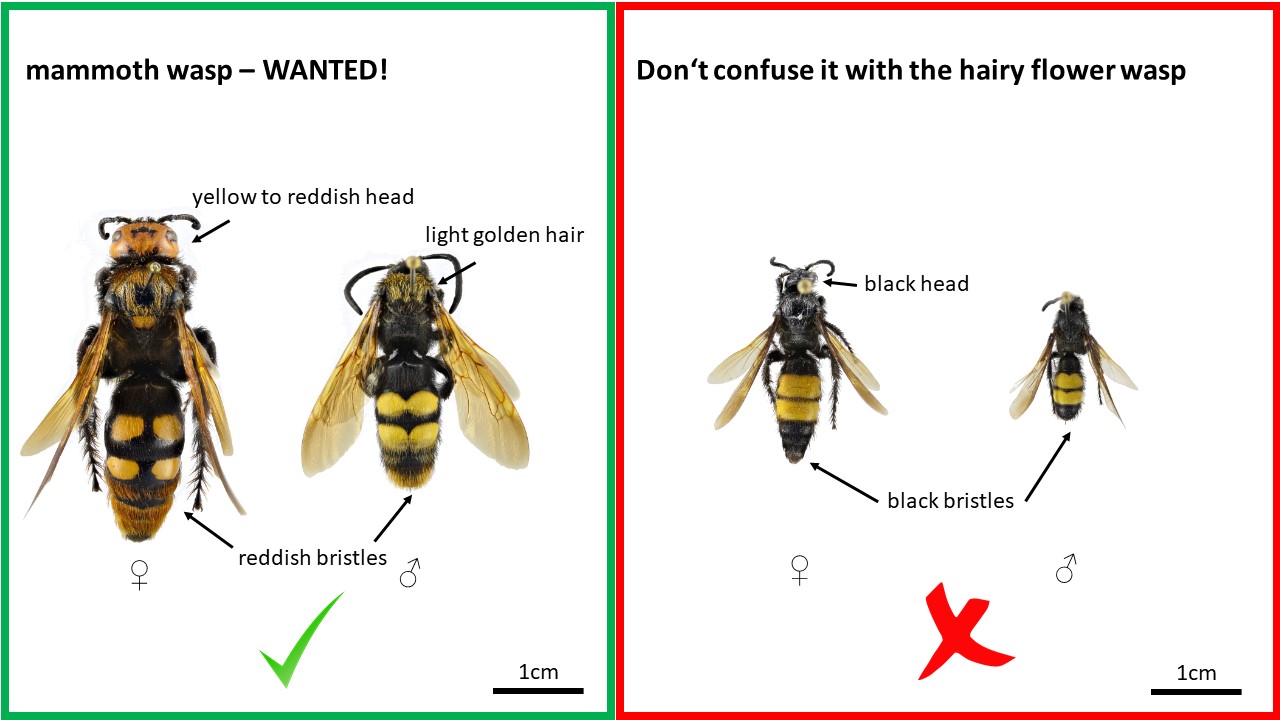
© Harald Schillhammer
Sighting reports
Sightings of the mammoth wasp with photo, date and exact location can be reported by email to This email address is being protected from spambots. You need JavaScript enabled to view it.. Furthermore, information on the plant species is also interesting if the wasp was observed visiting flowers.
The corresponding sighting data will be evaluated and published afterwards.
You will receive a confirmation or correction of your identification and if you wish, you will be mentioned by name in the article. The scientific publication will be sent to all who have contributed with their data.
Project goals
The aim of the project is to monitor the spread of the mammoth wasp Megascolia maculata in Austria using data submitted by Citizen Scientists. As in several other species, changes in the distribution are related to the climatic warming. If sufficient data are acquired, the diving factors in this process will also be scientifically analyzed.
In addition, the project aims to increase awareness of the native insect fauna and its dynamics. Observing and recognizing the largest wasp in Europe can also be an impressing experience.
Gallery
-
 Mammoth wasp in Austria © Franz Wieland Mammoth wasp in Austria © Franz Wieland
Mammoth wasp in Austria © Franz Wieland Mammoth wasp in Austria © Franz Wieland -
 Mammoth wasp on Common silk plant in Austria © Günter Gaß Mammoth wasp on Common silk plant in Austria © Günter Gaß
Mammoth wasp on Common silk plant in Austria © Günter Gaß Mammoth wasp on Common silk plant in Austria © Günter Gaß -
 Mammoth wasp on redcurrant in Austria © Gerhard Barisch Mammoth wasp on redcurrant in Austria © Gerhard Barisch
Mammoth wasp on redcurrant in Austria © Gerhard Barisch Mammoth wasp on redcurrant in Austria © Gerhard Barisch -
 Mammoth wasp in Austria © Gerhard Barisch Mammoth wasp in Austria © Gerhard Barisch
Mammoth wasp in Austria © Gerhard Barisch Mammoth wasp in Austria © Gerhard Barisch
https://www.citizen-science.at/en/component/k2/author/934-florianheigl?start=90#sigProId90fbf13b10
Project institution
This project fulfils version 1.1 of the quality criteria for citizen science projects on Österreich forscht.
Werkstatt Neu Leopoldau
The research project Werkstatt Neu Leopoldau is focused on the settlement process as a workshop situation for social innovations in housing and urban development, with the aim of fostering sustainable development and creating good neighbourhoods.
As an applied research project, "Werkstatt Neu Leopoldau" (Co-creation Neu Leopoldau) accompanies the settlement process of the IBA quarter in Vienna's 21st district. The phase of residents' and users' arrival in the neighbourhood is explored, which is conceived as a potential for social sustainability in Viennese housing. Using proven and new practices as a starting point, settlement processes are viewed as learning and education processes. Furthermore, it entails socially integrative potentials that should be shaped and further developed in a collaborative and co-creative setting to think about future ways of living in the neighbourhood.
In a first step, relevant topics and questions will be developed in a co-creative process based on the experiences of the actors involved. Special attention is paid to established and future social innovations in urban development (e.g. social innovations such as social support in the settlement process, community spaces, and sharing of further resources, etc.). In a synthesis step, a selection and focus on key topics are undertaken, which are then elaborated in more depth with the target groups in collaborative workshops. The aim of the innovation project is to develop transformational knowledge in a spatial context to enable and strengthen learning and educational processes at the individual and institutional level.
The project was carried out from November 2022 until September 2023, involving residents, tenants, property management companies, and experts who are accompanying the settlement process. Werkstatt Neu Leopoldau is supported by the IBA_Wien 2022 of the City of Vienna, MA 50, and a series of further cooperation partners.
Transdisciplinary research team
- future.lab Research Center TU Vienna: Christian Peer (project leader), Magdalena Augustin, Tamara Bauer, Ruth Höpler
- Citizen scientists: residents of Neu Leopoldau
- Practice partners: GB* district management Neu Leopoldau, property management and further experts, who professionally accompany the settlement process
Podcast episode
In September 2022, project leader Christian Peer was a guest on the Österreich forscht podcast "Wissen macht Leute" - if you're interested to learn more about the project, you can listen to the episode here (in German). In addition, Maria Schönswetter, a dedicated Citizen Scientist in the project, gave interesting insights into the project in March 2023 - tune in!
Results
You can download the final report directly from IBA_Vienna 2022 website or from the future.lab website!
Read more about the findings and results in our blog entry!
![]()
This project fulfilled version 1.1 of the quality criteria for citizen science projects on Österreich forscht.
Forest areas for the forest dormouse
Overview
You can tell by its name: The forest dormouse (Dryomys nitedula) is a characteristic species for deciduous and mixed forests. It belongs to the dormouse family and its survival is inextricably linked with forest habitats. The forest dormouse is protected throughout Europe, but data on its distribution is largely still missing. So where in Austria can it be found?
Have you ever seen a forest dormouse? With its black eye mask, it reminds us of a superhero in action, but in fact it spends a large part of the year in hibernation – a very typical behavior for a dormouse. Even during its activity period, it is a quite cryptic species that lives a hidden life between the branches of the trees. The forest dormouse is seldom seen, and it is not easy to prove its presence in an area. The forest dormouse is almost unknown even among foresters and regular forest guests.
Therefore, we are searching for the forest dormouse nationwide - beginning from the Danube floodplains, down to the mountains of the Alps. We want to find out more about this cryptic little climber and its habitat preferences and are counting on the help of numerous citizen scientists! There are many ways to take part in the “task force forest dormouse”. Become a citizen scientist and help us to find the forest dormouse!
Our project goals:
- Where does it live? – Improve the knowledge about the distribution of the forest dormouse in Austria.
- How can we preserve the habitats of the forest dormouse? – Develop a schedule of measures to protect the species.
What´s happening now:
- We installed 600 nesting boxes to monitor the forest dormouse populations.
- We use camera traps and footprint tunnels to detect our native dormice.
- We collect reports from citizen scientist.
- We provide information material and educational documents.
- We develop a protection concept and guidelines for forest managers.
- We share our knowledge at events.
Citizen Science Seminar
In 2022, poject coordinator Birgit Rotter held a lecture about "Forest areas for the forest dormouse" (in German) as part of the lecture series "Citizen Science Seminar" at the University of Natural Resources and Life Sciences Vienna (BOKU).
Image gallery
-
 Forest dormouse climbing in the branches (c) Lubomir Hlasek Forest dormouse climbing in the branches (c) Lubomir Hlasek
Forest dormouse climbing in the branches (c) Lubomir Hlasek Forest dormouse climbing in the branches (c) Lubomir Hlasek -
 Forest dormouse sitting on a branch (c) Lubomir Hlasek Forest dormouse sitting on a branch (c) Lubomir Hlasek
Forest dormouse sitting on a branch (c) Lubomir Hlasek Forest dormouse sitting on a branch (c) Lubomir Hlasek -
 Forest dormouse found in a nesting box (c) apodemus Forest dormouse found in a nesting box (c) apodemus
Forest dormouse found in a nesting box (c) apodemus Forest dormouse found in a nesting box (c) apodemus -
 Nesting box (c) Birgit Rotter Nesting box (c) Birgit Rotter
Nesting box (c) Birgit Rotter Nesting box (c) Birgit Rotter
https://www.citizen-science.at/en/component/k2/author/934-florianheigl?start=90#sigProId338a66d27d
This project fulfils version 1.1 of the quality criteria for citizen science projects on Österreich forscht.



